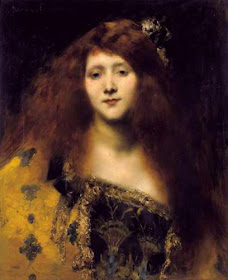Juana Romani (1867 - 1923/24) was born with the name Carolina Carlesimo in Italy. Her mother brought her to Paris, where she began working as an artist model as a child.

She decided to pursue an art career herself, studying with
Ferdinand Roybet and
Jean-Jacques Henner.
 |
| Salomé by Juana Romani |
She became known for her portraits of female subjects.
The influence of Henner and Roybet can be seen in the soft frontal lighting, which melts into profound shadows at the edges of the form. She painted directly on the canvas without much preliminary sketching.
Unfortunately her last years were not happy. She suffered from mental illness and lived in a psychiatric hospital, where she died forgotten.
-----
Book:
Women Artists in Paris, 1850-1900 Juana Romani on Wikipedia
Juana Romani on Wikipedia





Do you think she took her last name after the gypsy term, "Romani" or "Romany"?
ReplyDeleteThese are wonderful. The first one, in particular, caught my attention. That brocade - so rich.
Thanks James, for your efforts in highlighting these women artists. I was wondering this morning if I'm imagining or if I am actually sensing a certain (perhaps ineffable) quality about these paintings. Do they perhaps tend to be (for want of a better term) more sensitive, in general, than paintings by men artists of the same era? I suppose I'd have to take some sort of blind test to see if that's the case. Anyway, I find that interesting to ponder.
ReplyDeleteI've asked my library to order Women Artists in Paris, 1850-1900. I hope they will.
Beautiful, sensitive, work. I wonder about the mental illness. Often women who were unusual, unconventional and even just feisty or uncooperative, even depressives were often institutionalized to "deal" with them by their families or mates. Mary Todd Lincoln comes to mind. Later they were just medicated.
ReplyDeleteTom, I'd be tempted to think so, but then I ran across Lady Butler (Elizabeth Thompson), who was a military painter. If all I saw was her paintings, I would have thought they were by a guy for sure. So who knows? https://en.wikipedia.org/wiki/Elizabeth_Thompson
ReplyDeleteSusan, I'm not sure, but from everything else I've learned about her, she liked to present herself as exotic and mysterious. Sarah Bernhardt did too.
Janet, yes, sad but true. By the 1920s so many great academic painters were all but forgotten.
I see what you mean, James, about Lady Butler. I think that the thesis I proposed above would be hard to prove, and in any case social norms about what a woman "should" paint in those days might have skewed their paintings more toward subjects that would by their nature seem more "sensitive". My theory alone might well be a manifestation of my own gender bias in that regard.
ReplyDeleteJust looking at the pictures - wow. That is incredible!
ReplyDeleteOh, wasn't she marvelous!
ReplyDeleteJames, thanks for introducing us to yet another overlooked artist. Beautiful work. And Tom, thanks for asking your library to get the book. I suspect your library is my library.
ReplyDeleteI'm sure you'r right Steve. One of the best library systems I've ever seen. (We're overdue for that coffee; I'll email you after I return to town in a couple of weeks.)
ReplyDelete